Abstract
Long-circulating (stealth) liposomes coated with polyethylene glycol (PEG), which show reduced uptake by the reticuloendothelial system (RES) and enhanced accumulation in tumours, were used for conjugation to monoclonal antibodies (MAbs) as a drug-targeting device. A MAb (N-12A5) directed against erbB-2 oncoprotein, a functional surface antigen, was used. Amplification and overexpression of the erbB-2 gene product, being unique to malignancy, confer onto this antibody-mediated therapy high tumour specificity. In vitro binding of [3H]cholesteryl ether ([3H]Chol ether) labelled anti-erbB-2 conjugated liposomes to N-87 cells (erbB-2-positive human gastric carcinoma) was compared with the binding of non-targeted liposomes and indicated a 16-fold increase in binding for the targeted liposomes. No difference in binding to OV1063 cells (erbB-2-negative human ovary carcinoma) was observed. These results indicate highly selective binding of antibody-targeted liposomes to erbB-2-overexpressing cells. Despite increased cell binding, doxorubicin (DOX) loaded in anti-erbB-2-conjugated liposomes did not cause increased in vitro cytotoxicity against N-87 cells, suggesting lack of liposome internalisation. In vivo, the critical factor needed to decrease the non-specific RES uptake and prolong the circulation time of antibody-conjugated liposomes is a low protein to phospholipid ratio ( < 60 micrograms mumol-1). Using these optimised liposome preparations loaded with DOX and by monitoring the drug levels and the [3H]Chol ether label, biodistribution studies in nude mice bearing subcutaneous implants of N-87 tumours were carried out. No significant differences in liver and spleen uptake between antibody-conjugated and plain liposomes were observed. Nevertheless, there was no enhancement of tumour liposome levels over plain liposomes. Both liposome preparations considerably enhanced DOX concentration in the tumour compared with free drug administration. Therapeutic experiments with N-87 tumour-bearing nude mice indicated that anti-tumour activity of targeted and non-targeted liposomes was similar, although both preparations had an increased therapeutic efficacy compared with the free drug. These studies suggest that efficacy is dependent on drug delivery to the tumour and that the rate-limiting factor of liposome accumulation in tumours is the liposome extravasation process, irrespective of liposome affinity or targeting to tumour cells.
Full text
PDF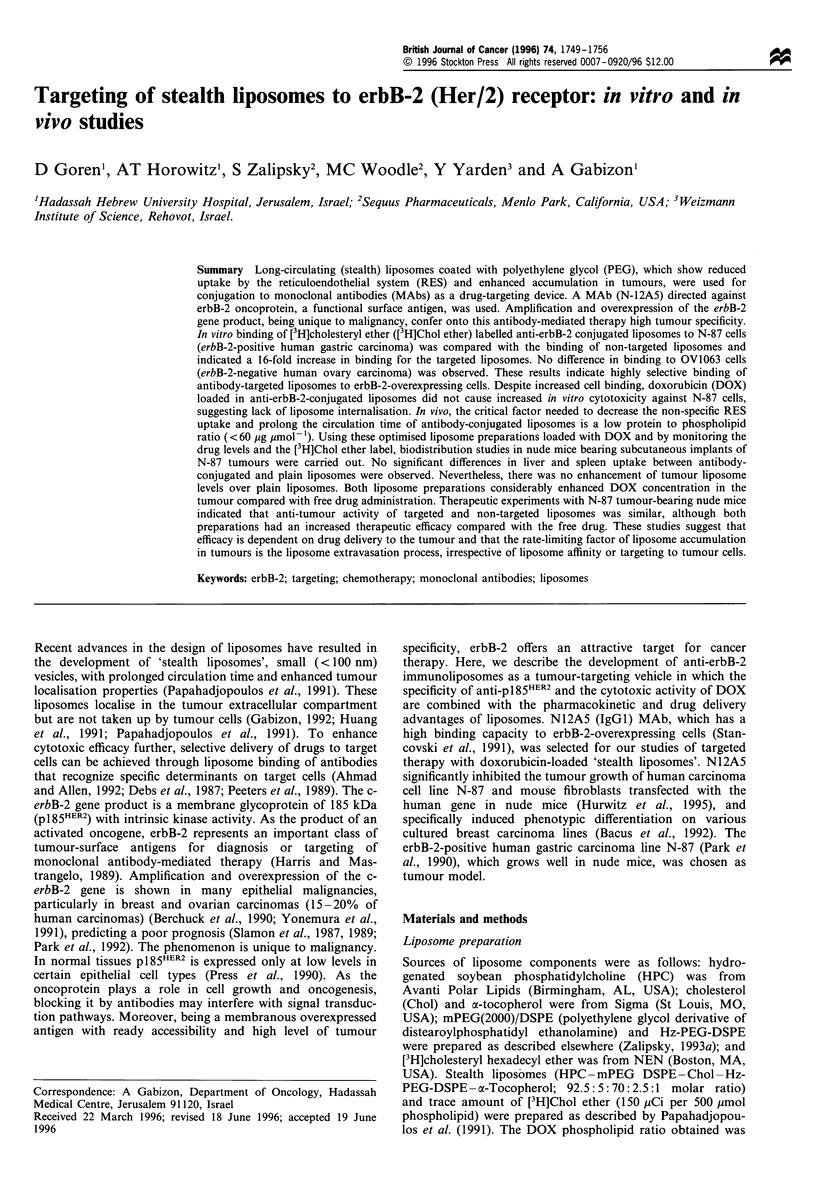
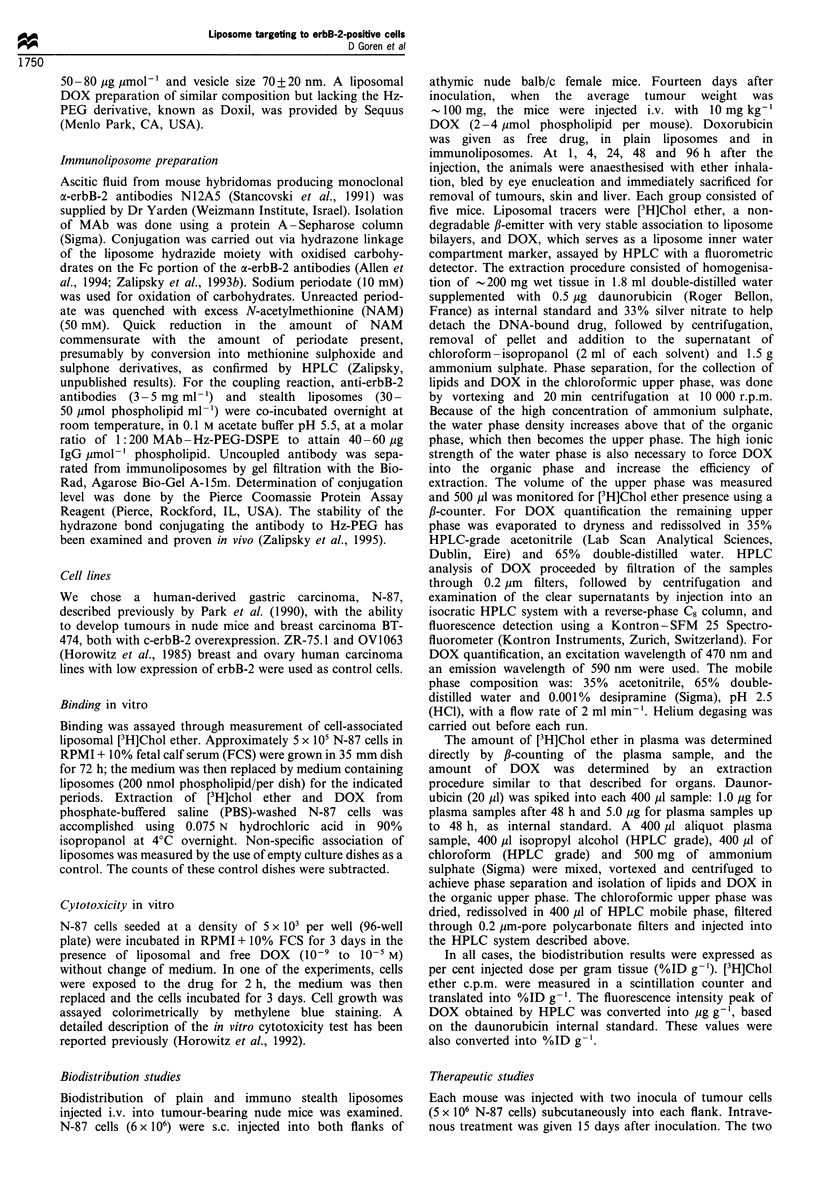
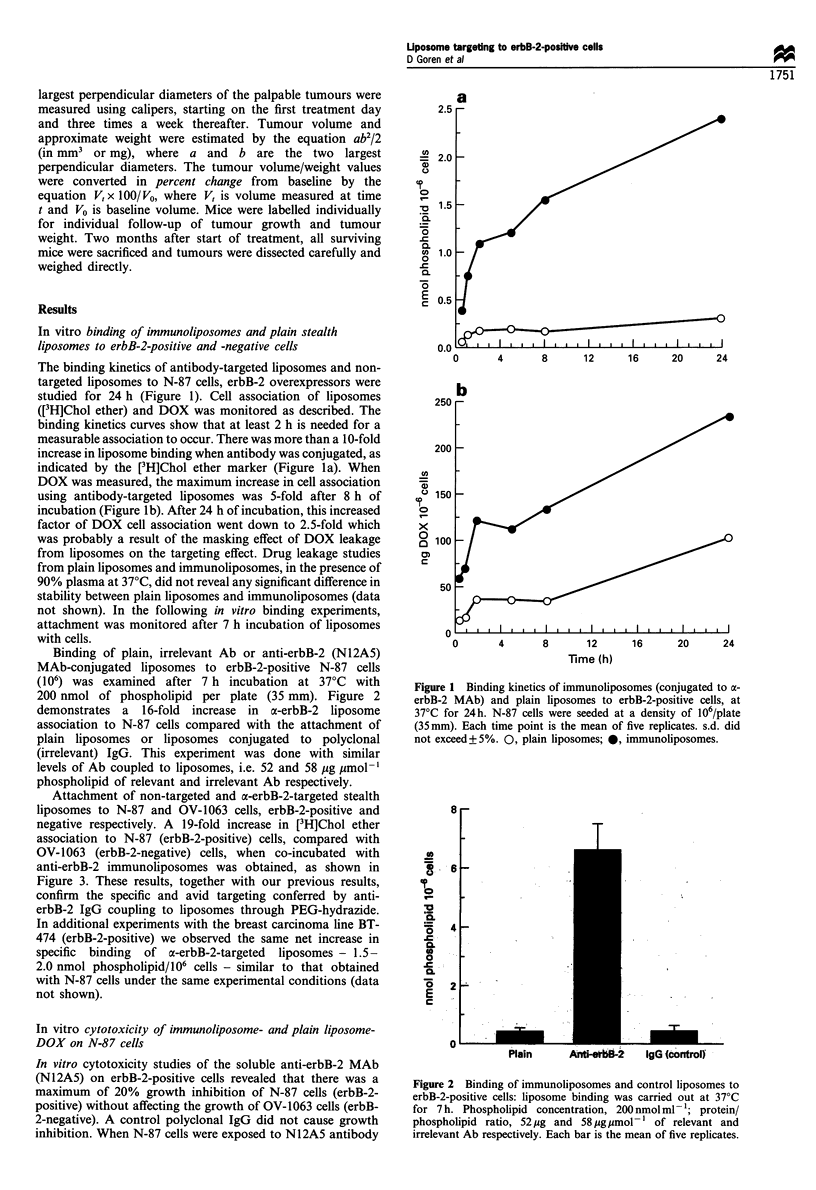
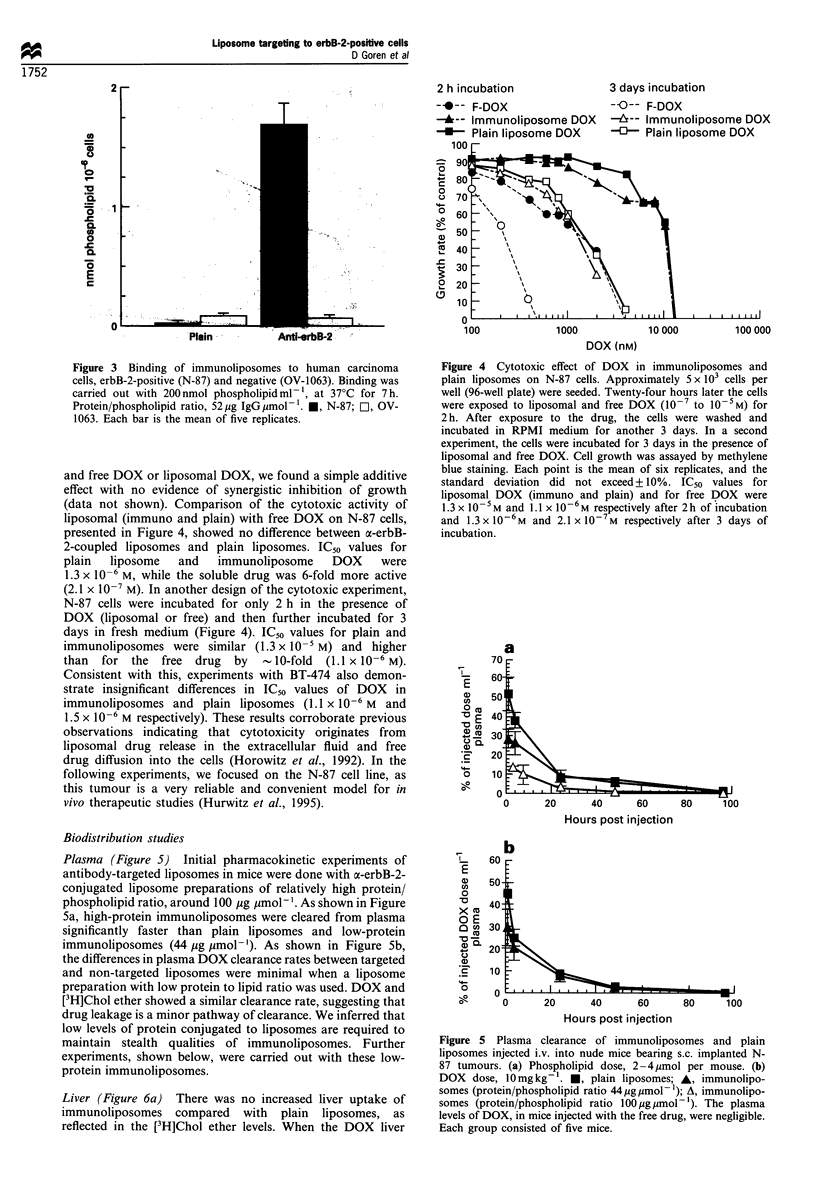
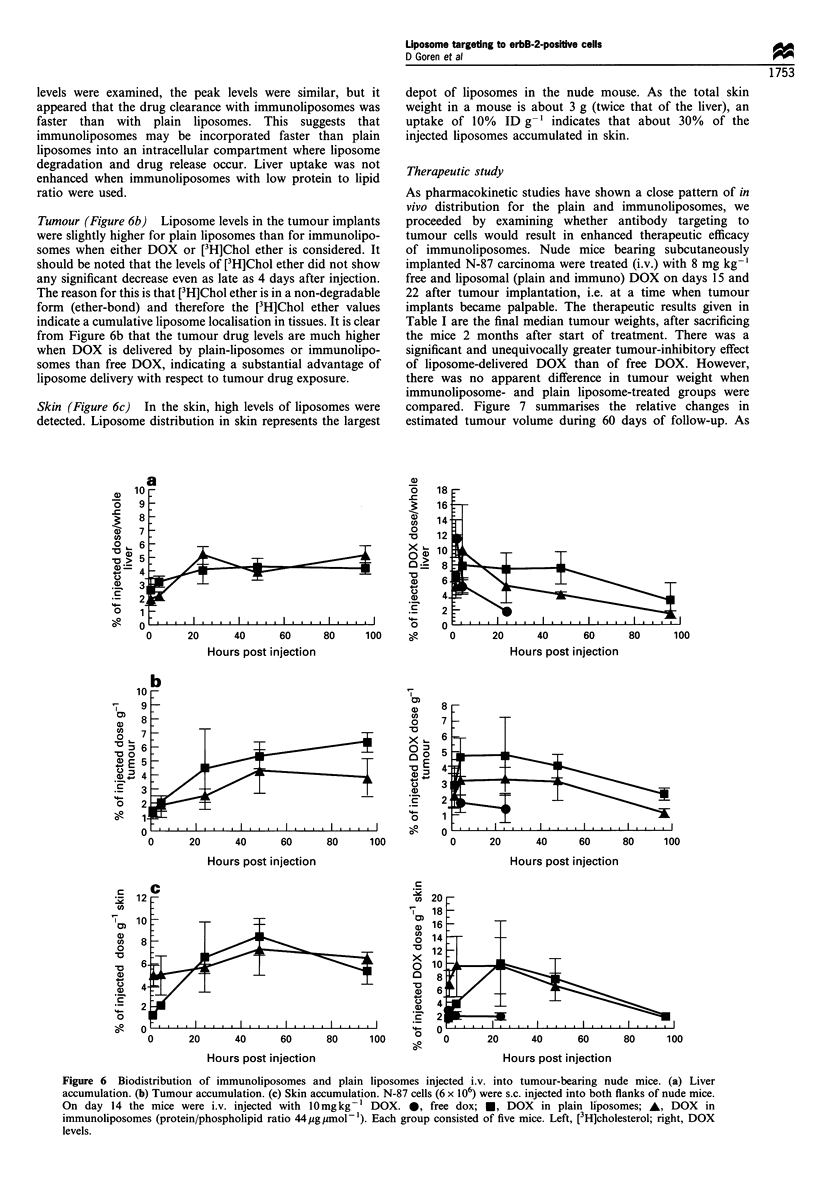
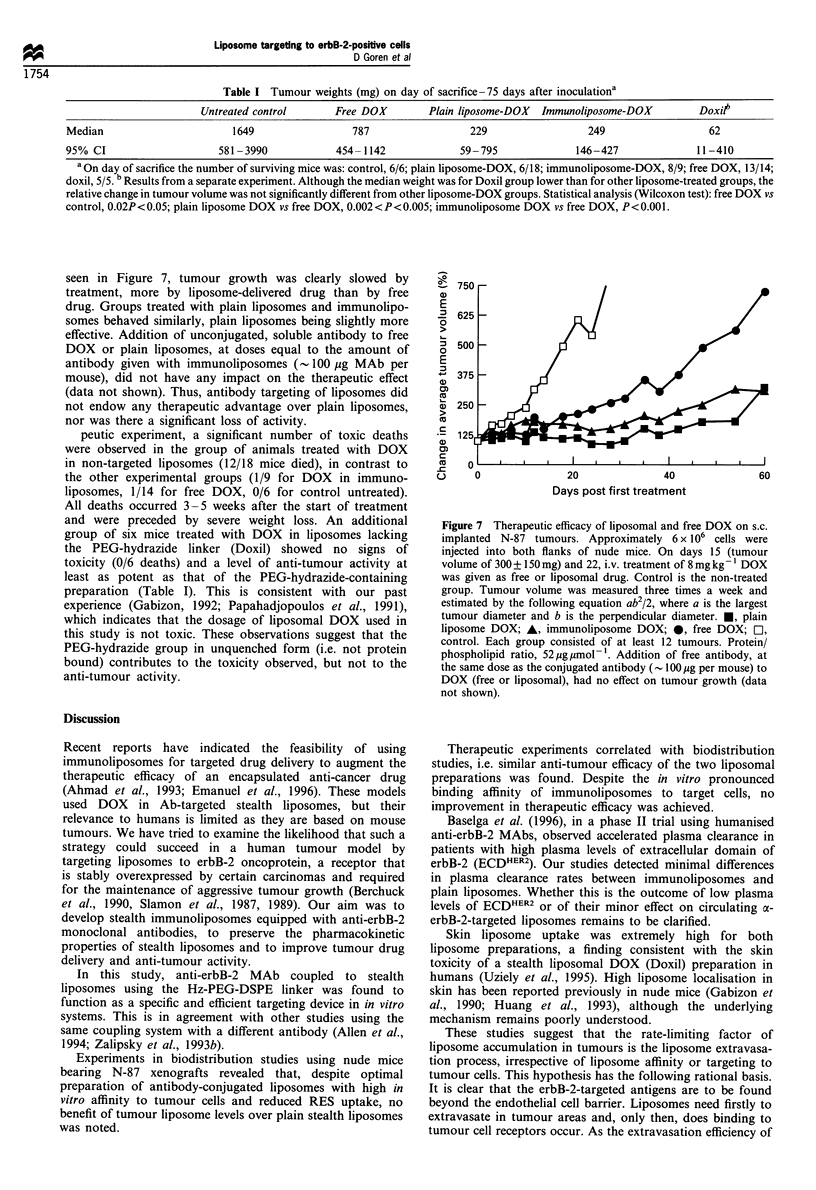
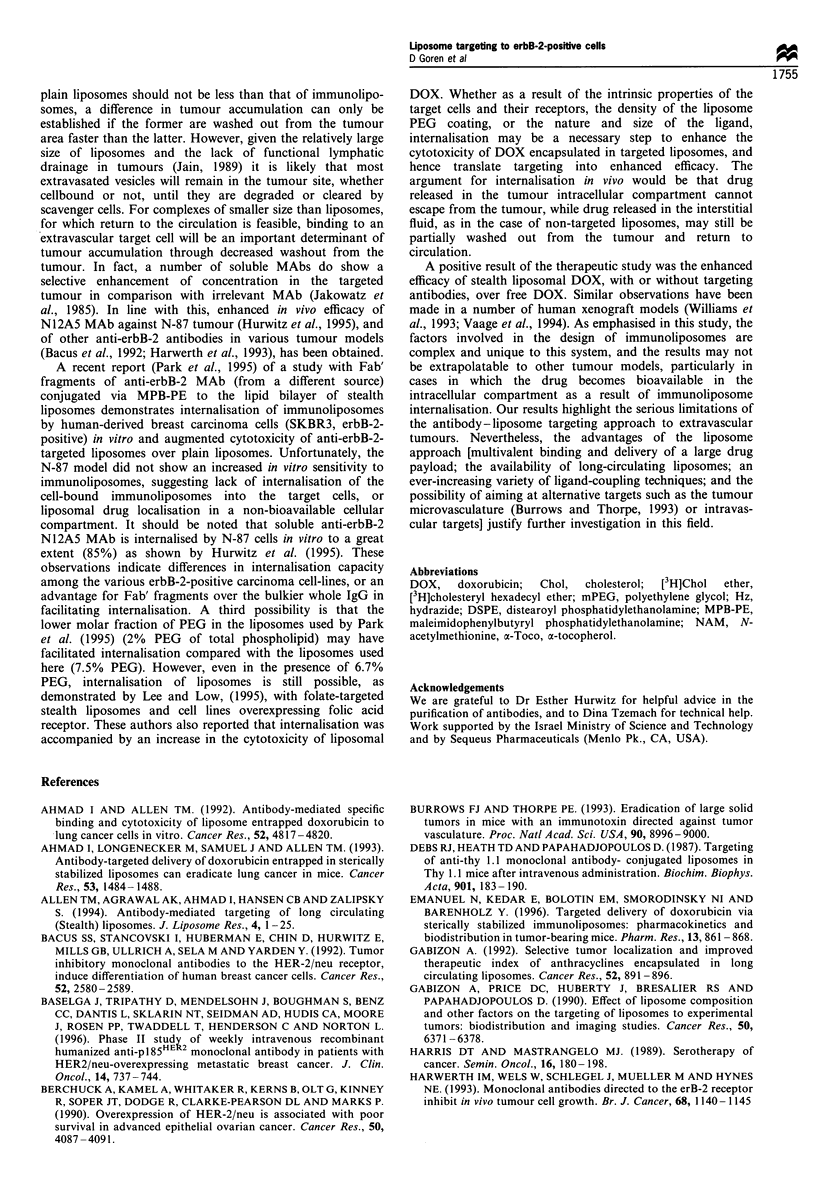

Selected References
These references are in PubMed. This may not be the complete list of references from this article.
- Ahmad I., Allen T. M. Antibody-mediated specific binding and cytotoxicity of liposome-entrapped doxorubicin to lung cancer cells in vitro. Cancer Res. 1992 Sep 1;52(17):4817–4820. [PubMed] [Google Scholar]
- Ahmad I., Longenecker M., Samuel J., Allen T. M. Antibody-targeted delivery of doxorubicin entrapped in sterically stabilized liposomes can eradicate lung cancer in mice. Cancer Res. 1993 Apr 1;53(7):1484–1488. [PubMed] [Google Scholar]
- Bacus S. S., Stancovski I., Huberman E., Chin D., Hurwitz E., Mills G. B., Ullrich A., Sela M., Yarden Y. Tumor-inhibitory monoclonal antibodies to the HER-2/Neu receptor induce differentiation of human breast cancer cells. Cancer Res. 1992 May 1;52(9):2580–2589. [PubMed] [Google Scholar]
- Baselga J., Tripathy D., Mendelsohn J., Baughman S., Benz C. C., Dantis L., Sklarin N. T., Seidman A. D., Hudis C. A., Moore J. Phase II study of weekly intravenous recombinant humanized anti-p185HER2 monoclonal antibody in patients with HER2/neu-overexpressing metastatic breast cancer. J Clin Oncol. 1996 Mar;14(3):737–744. doi: 10.1200/JCO.1996.14.3.737. [DOI] [PubMed] [Google Scholar]
- Berchuck A., Kamel A., Whitaker R., Kerns B., Olt G., Kinney R., Soper J. T., Dodge R., Clarke-Pearson D. L., Marks P. Overexpression of HER-2/neu is associated with poor survival in advanced epithelial ovarian cancer. Cancer Res. 1990 Jul 1;50(13):4087–4091. [PubMed] [Google Scholar]
- Burrows F. J., Thorpe P. E. Eradication of large solid tumors in mice with an immunotoxin directed against tumor vasculature. Proc Natl Acad Sci U S A. 1993 Oct 1;90(19):8996–9000. doi: 10.1073/pnas.90.19.8996. [DOI] [PMC free article] [PubMed] [Google Scholar]
- Debs R. J., Heath T. D., Papahadjopoulos D. Targeting of anti-Thy 1.1 monoclonal antibody conjugated liposomes in Thy 1.1 mice after intravenous administration. Biochim Biophys Acta. 1987 Jul 23;901(2):183–190. doi: 10.1016/0005-2736(87)90114-3. [DOI] [PubMed] [Google Scholar]
- Emanuel N., Kedar E., Bolotin E. M., Smorodinsky N. I., Barenholz Y. Targeted delivery of doxorubicin via sterically stabilized immunoliposomes: pharmacokinetics and biodistribution in tumor-bearing mice. Pharm Res. 1996 Jun;13(6):861–868. doi: 10.1023/a:1016096910822. [DOI] [PubMed] [Google Scholar]
- Gabizon A. A. Selective tumor localization and improved therapeutic index of anthracyclines encapsulated in long-circulating liposomes. Cancer Res. 1992 Feb 15;52(4):891–896. [PubMed] [Google Scholar]
- Gabizon A., Price D. C., Huberty J., Bresalier R. S., Papahadjopoulos D. Effect of liposome composition and other factors on the targeting of liposomes to experimental tumors: biodistribution and imaging studies. Cancer Res. 1990 Oct 1;50(19):6371–6378. [PubMed] [Google Scholar]
- Harris D. T., Mastrangelo M. J. Serotherapy of cancer. Semin Oncol. 1989 Jun;16(3):180–198. [PubMed] [Google Scholar]
- Harwerth I. M., Wels W., Schlegel J., Müller M., Hynes N. E. Monoclonal antibodies directed to the erbB-2 receptor inhibit in vivo tumour cell growth. Br J Cancer. 1993 Dec;68(6):1140–1145. doi: 10.1038/bjc.1993.494. [DOI] [PMC free article] [PubMed] [Google Scholar]
- Horowitz A. T., Barenholz Y., Gabizon A. A. In vitro cytotoxicity of liposome-encapsulated doxorubicin: dependence on liposome composition and drug release. Biochim Biophys Acta. 1992 Aug 24;1109(2):203–209. doi: 10.1016/0005-2736(92)90084-y. [DOI] [PubMed] [Google Scholar]
- Horowitz A. T., Treves A. J., Voss R., Okon E., Fuks Z., Davidson L., Biran S. A new human ovarian carcinoma cell line: establishment and analysis of tumor-associated markers. Oncology. 1985;42(5):332–337. doi: 10.1159/000226056. [DOI] [PubMed] [Google Scholar]
- Huang S. K., Hong K., Lee K. D., Papahadjopoulos D., Friend D. S. Light microscopic localization of silver-enhanced liposome-entrapped colloidal gold in mouse tissues. Biochim Biophys Acta. 1991 Oct 14;1069(1):117–121. doi: 10.1016/0005-2736(91)90111-k. [DOI] [PubMed] [Google Scholar]
- Huang S. K., Martin F. J., Jay G., Vogel J., Papahadjopoulos D., Friend D. S. Extravasation and transcytosis of liposomes in Kaposi's sarcoma-like dermal lesions of transgenic mice bearing the HIV tat gene. Am J Pathol. 1993 Jul;143(1):10–14. [PMC free article] [PubMed] [Google Scholar]
- Hurwitz E., Stancovski I., Sela M., Yarden Y. Suppression and promotion of tumor growth by monoclonal antibodies to ErbB-2 differentially correlate with cellular uptake. Proc Natl Acad Sci U S A. 1995 Apr 11;92(8):3353–3357. doi: 10.1073/pnas.92.8.3353. [DOI] [PMC free article] [PubMed] [Google Scholar]
- Jain R. K. Delivery of novel therapeutic agents in tumors: physiological barriers and strategies. J Natl Cancer Inst. 1989 Apr 19;81(8):570–576. doi: 10.1093/jnci/81.8.570. [DOI] [PubMed] [Google Scholar]
- Jakowatz J. G., Beatty B. G., Vlahos W. G., Porudominsky D., Philben V. J., Williams L. E., Paxton R. J., Shively J. E., Beatty J. D. High-specific-activity 111In-labeled anticarcinoembryonic antigen monoclonal antibody: biodistribution and imaging in nude mice bearing human colon cancer xenografts. Cancer Res. 1985 Nov;45(11 Pt 2):5700–5706. [PubMed] [Google Scholar]
- Lee R. J., Low P. S. Folate-mediated tumor cell targeting of liposome-entrapped doxorubicin in vitro. Biochim Biophys Acta. 1995 Feb 15;1233(2):134–144. doi: 10.1016/0005-2736(94)00235-h. [DOI] [PubMed] [Google Scholar]
- Papahadjopoulos D., Allen T. M., Gabizon A., Mayhew E., Matthay K., Huang S. K., Lee K. D., Woodle M. C., Lasic D. D., Redemann C. Sterically stabilized liposomes: improvements in pharmacokinetics and antitumor therapeutic efficacy. Proc Natl Acad Sci U S A. 1991 Dec 15;88(24):11460–11464. doi: 10.1073/pnas.88.24.11460. [DOI] [PMC free article] [PubMed] [Google Scholar]
- Park J. G., Frucht H., LaRocca R. V., Bliss D. P., Jr, Kurita Y., Chen T. R., Henslee J. G., Trepel J. B., Jensen R. T., Johnson B. E. Characteristics of cell lines established from human gastric carcinoma. Cancer Res. 1990 May 1;50(9):2773–2780. [PubMed] [Google Scholar]
- Park J. W., Hong K., Carter P., Asgari H., Guo L. Y., Keller G. A., Wirth C., Shalaby R., Kotts C., Wood W. I. Development of anti-p185HER2 immunoliposomes for cancer therapy. Proc Natl Acad Sci U S A. 1995 Feb 28;92(5):1327–1331. doi: 10.1073/pnas.92.5.1327. [DOI] [PMC free article] [PubMed] [Google Scholar]
- Park J. W., Stagg R., Lewis G. D., Carter P., Maneval D., Slamon D. J., Jaffe H., Shepard H. M. Anti-p185HER2 monoclonal antibodies: biological properties and potential for immunotherapy. Cancer Treat Res. 1992;61:193–211. doi: 10.1007/978-1-4615-3500-3_10. [DOI] [PubMed] [Google Scholar]
- Peeters P. A., Brunink B. G., Eling W. M., Crommelin D. J. Therapeutic effect of chloroquine(CQ)-containing immunoliposomes in rats infected with Plasmodium berghei parasitized mouse red blood cells: comparison with combinations of antibodies and CQ or liposomal CQ. Biochim Biophys Acta. 1989 Jun 6;981(2):269–276. doi: 10.1016/0005-2736(89)90037-0. [DOI] [PubMed] [Google Scholar]
- Press M. F., Cordon-Cardo C., Slamon D. J. Expression of the HER-2/neu proto-oncogene in normal human adult and fetal tissues. Oncogene. 1990 Jul;5(7):953–962. [PubMed] [Google Scholar]
- Slamon D. J., Clark G. M., Wong S. G., Levin W. J., Ullrich A., McGuire W. L. Human breast cancer: correlation of relapse and survival with amplification of the HER-2/neu oncogene. Science. 1987 Jan 9;235(4785):177–182. doi: 10.1126/science.3798106. [DOI] [PubMed] [Google Scholar]
- Slamon D. J., Godolphin W., Jones L. A., Holt J. A., Wong S. G., Keith D. E., Levin W. J., Stuart S. G., Udove J., Ullrich A. Studies of the HER-2/neu proto-oncogene in human breast and ovarian cancer. Science. 1989 May 12;244(4905):707–712. doi: 10.1126/science.2470152. [DOI] [PubMed] [Google Scholar]
- Stancovski I., Hurwitz E., Leitner O., Ullrich A., Yarden Y., Sela M. Mechanistic aspects of the opposing effects of monoclonal antibodies to the ERBB2 receptor on tumor growth. Proc Natl Acad Sci U S A. 1991 Oct 1;88(19):8691–8695. doi: 10.1073/pnas.88.19.8691. [DOI] [PMC free article] [PubMed] [Google Scholar]
- Uziely B., Jeffers S., Isacson R., Kutsch K., Wei-Tsao D., Yehoshua Z., Libson E., Muggia F. M., Gabizon A. Liposomal doxorubicin: antitumor activity and unique toxicities during two complementary phase I studies. J Clin Oncol. 1995 Jul;13(7):1777–1785. doi: 10.1200/JCO.1995.13.7.1777. [DOI] [PubMed] [Google Scholar]
- Vaage J., Barberá-Guillem E., Abra R., Huang A., Working P. Tissue distribution and therapeutic effect of intravenous free or encapsulated liposomal doxorubicin on human prostate carcinoma xenografts. Cancer. 1994 Mar 1;73(5):1478–1484. doi: 10.1002/1097-0142(19940301)73:5<1478::aid-cncr2820730526>3.0.co;2-1. [DOI] [PubMed] [Google Scholar]
- Williams S. S., Alosco T. R., Mayhew E., Lasic D. D., Martin F. J., Bankert R. B. Arrest of human lung tumor xenograft growth in severe combined immunodeficient mice using doxorubicin encapsulated in sterically stabilized liposomes. Cancer Res. 1993 Sep 1;53(17):3964–3967. [PubMed] [Google Scholar]
- Yonemura Y., Ninomiya I., Yamaguchi A., Fushida S., Kimura H., Ohoyama S., Miyazaki I., Endou Y., Tanaka M., Sasaki T. Evaluation of immunoreactivity for erbB-2 protein as a marker of poor short term prognosis in gastric cancer. Cancer Res. 1991 Feb 1;51(3):1034–1038. [PubMed] [Google Scholar]
- Zalipsky S. Synthesis of an end-group functionalized polyethylene glycol-lipid conjugate for preparation of polymer-grafted liposomes. Bioconjug Chem. 1993 Jul-Aug;4(4):296–299. doi: 10.1021/bc00022a008. [DOI] [PubMed] [Google Scholar]


